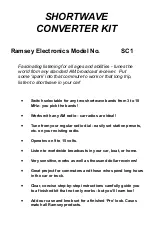
UMAX141200. Wi-Fi to CAN Converter. Version 1
Page: 36-44
8 TECHNICAL SPECIFICATIONS
8.1 Power Supply
The power supply uses automotive battery power.
Table 7. Power Supply Input
Parameter
Value
Remarks
Supply Voltage
9…36 VDC
12V, 24V – nominal
Supply Current
1
65 mA
35 mA
Maximum at 12V
Maximum at 24V
Protection
Reverse Polarity,
Overvoltage, Transients
1
CAN bus is connected. Wi-Fi is in station mode connected to an access point.
8.2 Wi-Fi
Port
Table 8. Wi-Fi Port Parameters
Parameter
Value
Remarks
Wireless Standards
802.11 a/b/g/n
802.11 a/b/g in Access Point mode
Frequency Ranges
2.4 GHz, 5 GHz
Available channels depend on the user
selectable country/region of operation.
Antenna
Internal
Communication Range
40 m
Reliable communication between two converters
in open space
Connectivity Modes
Station, Access Point
Maximum Number of
Stations
4
In Access Point mode
Security
Open, WEP, WPA /
WPA2-PSK
Firmware update
OTA
Using internal web server
Communication
Protocols
IP, ICMP, ARP, UDP,
TCP, HTTP,
Proprietary
1
CAN messages are transmitted using a
proprietary application protocol running on top of
the user selectable UDP or TCP transport
protocol [1].
Internal web server uses HTTP protocol. The
unit supports an Axiomatic proprietary discovery
protocol [2].
Server Mode
Up to 10 bi-directional
simultaneous
connections
Up to 9 connections, if the Client mode is
enabled
Client Mode
1 remote connection
Auto-connect to a remote server if connection is
dropped or temporary unavailable. Client mode
can be disabled.
Web server
Provided
Always enabled for converter configuration,
diagnostics, and OTA firmware update
Internal Diagnostics
Health Status
1
Internal health status of the converter is
transmitted in heartbeat messages [3]. It is also
available from the web server.
Wi-Fi Hibernation State
Provided
Controlled by an external digital input
1
Supported by
CAN-ENET Software Support Package
(SSP), p/n AX140910, v2.0.0+.










































